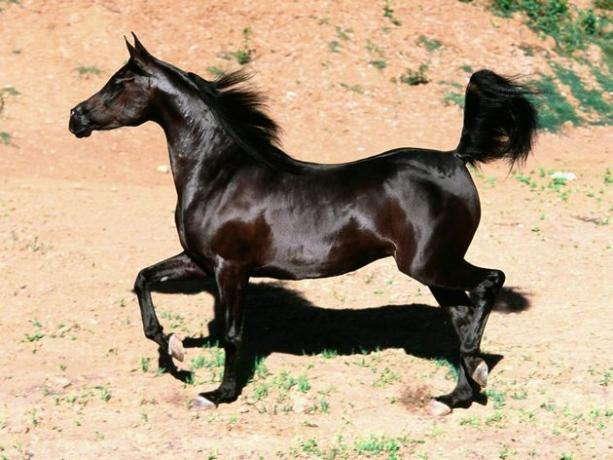The horse (equus caballus) is a vertebrate, ungulate and medium-sized mammal. Horses are part of the group of horses, the same as the zebra, donkey, pony and donkey.
Horses have coexisted with man for a long time, and the domestication of the species occurred 5,500 years ago a. Ç. Therefore, it represents one of the most used and most familiar animals with humans.
This is because horses are used for leisure, breeding, transporting people and goods and sports.
Horse characteristics
Horses are found all over the world, with the exception of extremely cold places like Antarctica.
The horse's weight varies from 350 to 500 kg, the height is 1.85 m in height, from the ground to the top of the head, and 2.25 m in length, beyond the tail.
Horses can live from 25 to 40 years. They are fast animals, the purebred English breed, for example, can reach up to 60 km/h.
The horse's body is covered with short, straight hair of varying color. The head is elongated, the eyes are wide apart and the nostrils are open. The ears are pointed and can move towards the sound.

horses are herbivorous animals, therefore, it is common to find them in pastures where they feed on grass and herbs. A horse, in the wild, can spend up to 16 hours feeding during the day.
When horses are man-made, they can still be fed feed or corn. It is also important to provide mineral salt.
When living in groups, horses communicate well with each other, their body posture can indicate actions and serve as an alert for flight or fight. For example, by looking at the horse's physical expressions it is possible to tell if it is scared, cornered or aggressive.
Horse breeding
The female, called a mare, allows contact with the male when in heat, a period that can last up to 12 days. At this point, the female becomes receptive to the male and many changes take place in her genitals.
To attract the male, the female urinates and exposes her vulva. When the two approach, mount occurs and, consequently, copulation.
Gestation lasts 11 months and usually gives rise to a foal (calf). The foal can already stand up after two hours of giving birth, and soon starts to risk the first steps.
Learn more, read also:
- Vertebrate animals
- Mammals
- Strings
horse races
It is estimated that there are more than 100 horse breeds in the world. Biologically, there are no races in the taxonomic classification, but the term was created to group individuals that have physical characteristics in common and can cross each other, transmitting the characteristics to their descendants.
In the case of horses, there are still some wild breeds in Asia and Europe. They are animals that live free in nature and have not been domesticated by man. Some of the horse breeds are:
Mangalarga marcher

The marchador mangalarga is a Brazilian breed, the result of crossing species from the Iberian Peninsula brought to Brazil at the time of colonization.
It is medium sized with a strong and robust body, being considered ideal for sports and transport.
Mangalarga

The mangalarga or mangalarga paulista results from the crossing of the Alter and Andaluz breeds. It is a saddle horse, ideal for sport and load work.
Its main characteristic is the trotted gait and strong limbs and joints.
Pure English blood

The English Thoroughbred is recognized for being a brave and swift animal. He is very popular as a racehorse as he is one of the fastest races.
Arabic

The Arabian horse or Arabian thoroughbred is widely used in equestrian sports. They have a shorter muzzle, long neck and expressive eyes. It is believed to be one of the oldest horse breeds.
A quarter of a mile

The quarter mile is originally from North America, adapted for working with cattle. It is a docile breed and easy to tame. He is also capable of covering great distances in a short time.
Fun facts about horses
- In some countries, horse meat is very popular for food.
- Some horses of nobler breeds can cost up to R$ 15 thousand.
- The horse may have moments of deep sleep, even dreaming.



